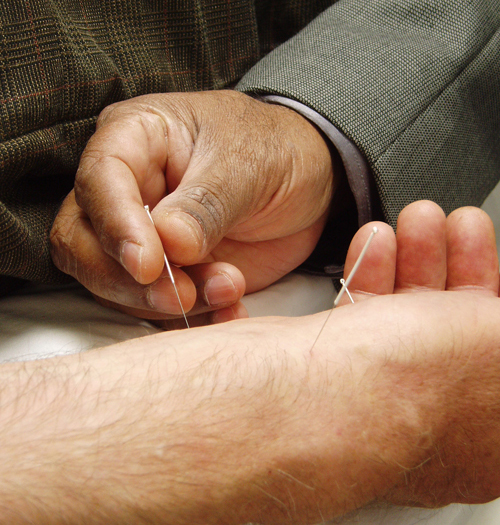Archive for November 2013
Carpal Tunnel Syndrome
Carpal tunnel syndrome (CTS) is caused by the entrapment of the median nerve in the wrist that then causes paresthesia, pain, numbness, and other symptoms in the distribution of the median nerve. It appears to be caused by a combination of genetic and environmental factors. Some of the predisposing factors include: diabetes, obesity, pregnancy, hypothyroidism, and heavy manual work or work with vibrating tools. The main symptom of CTS is intermittent numbness of the thumb, index, long and radial half of the ring finger. Long-standing CTS leads to permanent nerve damage with constant numbness, atrophy of some of the muscles of the thenar eminence, and weakness of palmar abduction.
Herniated Disc
A Spinal disc herniation (prolapsus disci intervertebralis) is a medical condition affecting the spine in which a tear in the outer, fibrous ring (annulus fibrosus) of an intervertebral disc (discus intervertebralis) allows the soft, central portion (nucleus pulposus) to bulge out beyond the damaged outer rings. Disc herniations are normally a further development of a previously existing disc “protrusion”, a condition in which the outermost layers of the annulus fibrosus are still intact, but can bulge when the disc is under pressure. In contrast to a herniation, none of the nucleus pulposus escapes beyond the outer layers.
Fibromyalgia
Fibromyalgia (FM or FMS) is characterized by chronic widespread pain and allodynia (a heightened and painful response to pressure). Its exact cause is unknown but is believed to involve psychological, genetic, neurobiological and environmental factors. Fibromyalgia symptoms are not restricted to pain, leading to the use of the alternative term fibromyalgia syndrome for the condition. Other symptoms include debilitating fatigue, sleep disturbance, and joint stiffness. Some patients also report difficulty with swallowing, bowel and bladder abnormalities, numbness and tingling, and cognitive dysfunction. Fibromyalgia is frequently comorbid with psychiatric conditions such as depression and anxiety and stress-related disorders such as posttraumatic stress disorder. Not all fibromyalgia patients experience all associated symptoms
Sciatica
Sciatica is a set of symptoms including pain caused by general compression or irritation of one of five spinal nerve roots of each sciatic nerve—or by compression or irritation of the left or right or both sciatic nerves. Symptoms include lower back pain, buttock pain, and pain, numbness or weakness in various parts of the leg and foot. Other symptoms include a “pins and needles” sensation, or tingling and difficulty moving or controlling the leg. Typically, symptoms only manifest on one side of the body. The pain may radiate below the knee, but does not always.
Acupuncture
Acupuncture is a collection of procedures involving penetration of the skin with needles to stimulate certain points on the body. In its classical form it is a characteristic component of traditional Chinese medicine (TCM). It has been categorized as a complementary health approach. According to traditional Chinese medicine, stimulating specific acupuncture points corrects imbalances in the flow of qi through channels known as meridians. Scientific investigation has not found any histological or physiological correlates for traditional Chinese concepts such as qi, meridians, and acupuncture points, and some contemporary practitioners use acupuncture without following the traditional Chinese approach.
“Acupuncture’s use for certain conditions has been recognized by the United States National Institutes of Health, the National Health Service of the United Kingdom, the World Health Organization, and the National Center for Complementary and Alternative Medicine. “
The general theory of acupuncture is based on the premise that bodily functions are regulated by an energy called qi which flows through the body; disruptions of this flow are believed to be responsible for disease. Acupuncture describes a family of procedures aiming to correct imbalances in the flow of qi by stimulation of anatomical locations on or under the skin (usually called acupuncture points or acupoints), by a variety of techniques. The most common mechanism of stimulation of acupuncture points employs penetration of the skin by thin metal needles, which are manipulated manually or by electrical stimulation.

- Autism
- Chronic asthma
- Bell’s palsy
- Cocaine dependence
- Depression
- Drug detoxification
- Primary dysmenorrhoea (incorporating TENS)
- Enuresis
- Epilepsy
- Erectile dysfunction
- Fibromyalgia
- Glaucoma
- Gynaecological conditions (except possibly fertility and nausea/vomiting)
- Hot flashes
- Insomnia
- Irritable bowel syndrome
- Induction of childbirth
- Myopia
- Polycystic ovary syndrome
- Rheumatoid arthritis
- Shoulder pain
- Schizophrenia
- Smoking cessation
- Acute stroke
- and stroke rehabilitation
- Temporomandibular joint dysfunction.
- Tennis elbow
- Uremic pruritus
- Vascular dementia